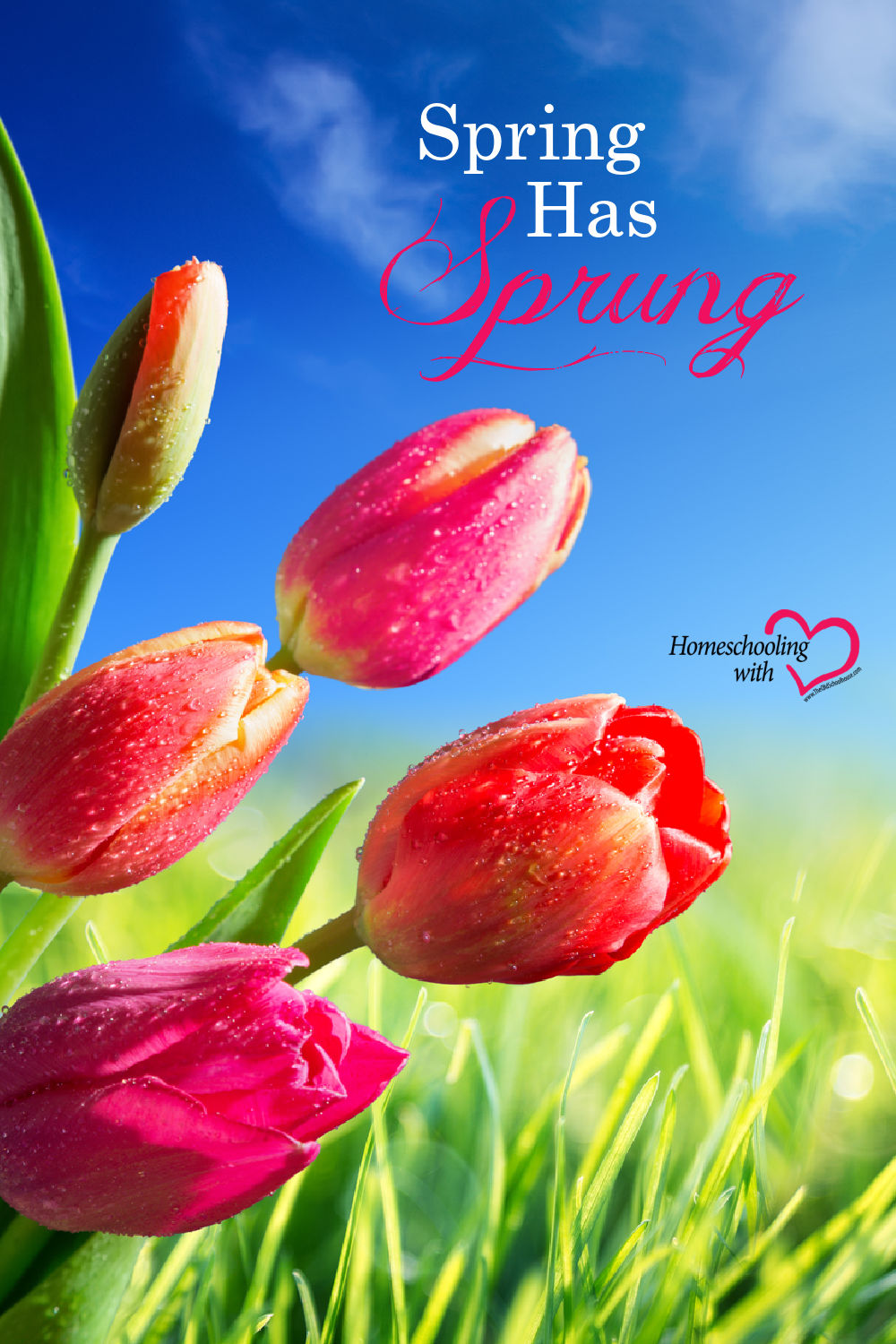Spring Has Sprung


Ahhh… Spring. Often called the season of renewal. For many moms, it’s the season of “get out of the house.” After gloomy days of winter, our mood is brighter, and our children are ready to stretch their legs. It won’t be long before the hot days of summer will be here and even more time can be spent outside. Not only does being outdoors offer much needed and healthy exercise, it can also be a learning experience.
Before we begin to look at some of learning activities, I’d like to give a little advice.
Please don’t make it school. In other words, don’t plan a specific lesson, go outside carry out the lesson, then come back to the table for math. Each of these activities can be done without planning and as the moment happens.
Your child will remember what is learned when it just happens, rather than a specifically planned academic activity. Keep these ideas in mind or make a list on the refrigerator to glance at now and then. As the spring weather warms up and you’re ready to strike out the door, a lesson note can be recorded later—after the fun.
Weather
I lived in an area called “The Land of Four Seasons.” The locals quipped, “Stick around for a day, you’ll experience all four.” Spring provides a variety of weather lessons: frost in the morning, sunshine and warm temperatures in the afternoon.
Rain is a predominant weather pattern in the spring. The old saying “April showers bring May flowers” is not without merit. I love a spring rain. I enjoy taking a walk in the rain. A spring rain just seems special. What better way to learn about rain than to experience it? Put on jackets, old shoes or rain boots, and head outdoors. Look at leaves, the side of the house, or the sidewalk while the rain is coming down. What’s happening? In many cases, the rain is gently cleaning, just like a shower at the end of the day. Often the question asked is “Where does the rain come from?” Well, we all can see it comes from the sky or from the clouds. But how does rain get there? This is a good time to begin talking about the water cycle. Be simple: Water on the ground, in the ocean, or in a lake warms up, evaporates, and floats to the sky to become clouds. That’s it. Not a huge science lesson but a concept to build on later in your child’s education. Some older children may be interested in cloud formation, spring weather patterns, and weather prediction.
And, Mom, be ready. One of the kiddos will stomp in the mud. That’s OK. Mud washes off. After some rainy fun, go in, dry off, have some hot cocoa, and read about Noah. Thank God that He will not flood the earth again.
Gardens, Flowers, and Bugs
A good time to go out and look for new plants coming up is a couple days after playing in the rain. Where did those plants come from? Seeds, of course. Not all seeds are carefully planted; some are blown in or dropped by birds. If you have a vegetable garden, you may have begun planting or tending a new garden now. Even your toddler can go in the garden with you. Designate a play area. Again, it’s OK for children to get dirty. Have some child-sized digging tools. Maybe a bug or worm will show up for the fun.
Generally, bugs are not dangerous. Sure, some of us may consider worms yucky, but they don’t bite. Young children learn their attitudes from us. If we show fear, they will learn that fear. God created slimy, ugly, and creepy things for a reason. They all have a purpose—a good purpose. While caution is needed with some insects, learn why God made them and teach your children. Let me start you off with an example: God created spiders to eat other bugs so those bugs don’t over populate. I often tell children, “Spiders are our friends.”
Children like to plant their own vegetables. There’s no better way to get a child to eat a veggie than to allow them to grow it. Again, have a special place in your garden for your child’s own garden. A small patch of carrots is a good starting point. Carrots grow quickly and are hardy. After the first crop is harvested, plant some more. Watch the growth of the carrot root by picking one every week or so. Not only look at it, taste it at each step of growth. Try some Parisian carrots. Rather than the usual long tubular root, the Parisian carrot is a small round ball. These are easy for a child to handle and eat.
The idea of watching the grass grow is often scoffed at. Seriously, get on your tummy, face-to-face with your child and look at the grass. You’ll be amazed at what can be found by taking the time to be quiet and look. Pull the grass blades apart, and you’ll see there is more than dirt. This is an activity not to be rushed. Enjoy seeing God’s creation close up.
Birds
If you have birdfeeders, you may see birds all year. But with spring, new birds will be coming to the yard. Watch the feeder for new ones. Have your child point out any new birds seen. Some birds are easy to identify: blue jays, cardinals, robins. Others take a little more time to figure out. Take some pictures of the birds dining in your yard and use books or the internet to identify them. A year-round family activity might be recording which birds arrive at various times of the year.
If you look carefully in trees and bushes, you may even find a bird nest. We’ve had small birds nest in our newspaper box. Some birds will return to the same nest each year. Carefully look in for eggs but never touch a bird nest. You and your little one can watch the babies grow, venture out of the nest, and one day you’ll notice they’ve gone.
Cornell University has a backyard birdwatcher program, which is fun for children and adults to take part in. Their website also has recordings of various bird songs. Occasionally, you can watch birds in their nest with a nest cam. Go to the website and click on the Live Cams menu item to see a list of birds to watch (www.allaboutbirds.org).
Global Bird Day is designated on May 8 this year. Billed as a “celebration of birds around you,” the day is designated to observe and record the birds visiting your yard on that day. Ebirds.org has recommendations and an e-course for observing and recording (https://ebird.org/news/global-big-day-8-may-2021). Oh, by the way, birds eat those slimy, ugly, and creepy bugs. All things have a purpose in God’s creation.
Health and Exercise
It’s good to get up and move. Children and adults need to get outside to walk, run, and play. Yes, I mean even play in the dirt and mud. I know I sound repetitive. Our society has become obsessed with clean to the detriment of all of us. Studies are being conducted that show children who play in the dirt are healthier and have stronger immune systems. If it’s good for your child, it can’t hurt you to get down on the ground and help dig. On warm days, when playtime is over, grab the hose and squirt the dirt off. *
You may find some bugs or interesting rocks while playing in the dirt, but more importantly, you’ll be creating memories for your child. These fun memories will come back later on when rock formations or dirt are being studied as a part of science. Don’t be surprised to hear your child say, “Remember when we played in the dirt and found …”
Spring is a time of renewal and a time to be outdoors, learning and playing. It can be a time for the family to enjoy God’s nature and each other.
*Also see “The Hygiene Hypothesis: Are Cleanlier Lifestyles Causing More Allergies For Kids?” ScienceDaily, September 9, 2007. https://www.sciencedaily.com/releases/2007/09/070905174501.htm
The National Wildlife Federation issued this report, “The Dirt on Dirt,” in 2012 https://www.nwf.org/~/media/PDFs/Be%20Out%20There/Dirt_Report_2012.ashx
Susan K. Stewart, Nonfiction Managing Editor with Elk Lake Publishing, teaches, writes, and edits non-fiction. Susan’s passion is to inspire readers with practical, real-world solutions. Her books include Science in the Kitchen, Preschool: At What Cost?, Harried Homeschoolers Handbook, and the award-winning Formatting e-Books for Writers. Her latest book, Donkey Devos: Listening to you donkey when God speaks, is scheduled to be released spring 2021. You can learn more at her website www.practicalinspirations.com.













































